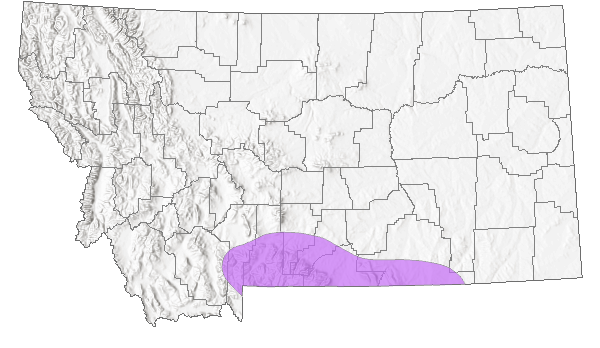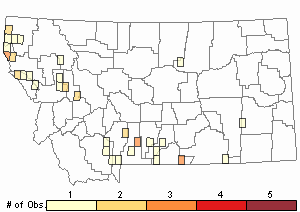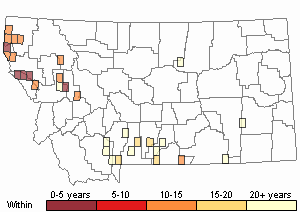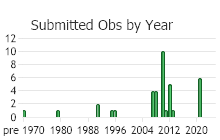View in other NatureServe Network Field Guides
NatureServe
Montana
Utah
Wyoming
Idaho
Wisconsin
British Columbia
South Carolina
Yukon
California
New York
Utah Serviceberry - Amelanchier utahensis
Native Species
Global Rank:
G5
State Rank:
S3S4
(see State Rank Reason below)
C-value:
4
Agency Status
USFWS:
USFS:
BLM:
External Links
State Rank Reason (see State Rank above)
Amelanchier utahensis has been found in southwest Montana. Identification of Amelanchier taxa has been difficult due to relatively few informative morphologic characters, and variability of some of these characters (Campbell et al. in FNA 2014). Good specimens of Amelanchier utahensis have been found in Gallatin and Stillwater Counties (Lesica et al. 2012). Many specimens or observations have been found in other southwestern and south-central counties but need to be verified. Habitat appears to be common and stable. Threats have not been identified. Taxonomic clarification and ecological information is needed to better document the status of Utah Serviceberry in Montana.
- Details on Status Ranking and Review
Range Extent
ScoreE - 5,000-20,000 sq km (~2,000-8,000 sq mi)
Comment15,212 square kilometers
Area of Occupancy
ScoreD - 6-25 4-km2 grid cells
CommentPlant occurs in 16 of the 30,590 4x4 square-kilometer grid cells that cover Montana.
Number of Populations
ScoreB - 6 - 20
Comment18 observations
Environmental Specificity
ScoreC - Moderate. Generalist or community with some key requirements scarce
Threats
ScoreD - Low
General Description
PLANTS: Shrubs with smooth, reddish bark that becomes gray with age and stems 1–2 meters high and intricately branched.
LEAVES: Single blade (simple) with a petiole. Leaf blade is ovate to broadly elliptic, rounded to blunt at the tip, and dentately toothed on the upper portion. Leaves are 1–3 cm long and tomentose beneath.
INFLORESCENCE: A short, bracteate raceme of 3 to 6 flowers that occur at the ends of branches. Flowers have a 1-2 mm hypanthium, reflexed sepals of 1–4 mm long, and white petals of 5–10 mm long. The single pistil has 2 or 3 separate styles. The fruit is a pome 5–10 mm long with 3 to 6 seeds. Fruit (pulp) is more reddish.
Named for Utah, where it was first discovered.
Sources: Campbell et al. in FNA 2014; Hitchcock et al. 1961; Lesica et al. 2012; and Little 1979.
Phenology
Flowering April through May. Fruiting July through September. Source: Campbell et al. in FNA 2014.
Diagnostic Characteristics
Saskatoon Serviceberry and
Utah Serviceberry are often difficult to separate. Species are separated by a combination of characteristics. In Montana Utah Serviceberry might not be a valid species (Peter Lesica personal communication).
Utah Serviceberry - (
Amelanchier utahensis), native :
*
permanent sparsely to moderately hairy leaves and twigs,
* rounded to truncate or emarginate leaf tips,
* relatively shorter petals, 5-10 mm long, and
* fewer stamen and style numbers; pistil with 2-3 styles.
* pome with more seeds, about 10.
* Leaves are pretty small (Walt Fertig personal communication).
Saskatoon Serviceberry - (
Amelanchier alnifolia):
* leaves with less persistent hairs; sparsely puberulent by flowering time and glaucous beneath,
* Raceme with 5-15 flowers,
* generally more stamen and style numbers; pistil with 4-5 styles,
* relatively longer petals, 8-18 mm long, and
* pome with fewer seeds, about 3-6.
Fruit (Pome)Pome color has been used to separate Saskatoon and Utah Serviceberry, but color will depend upon fruit maturity, environmental conditions, plant health, and geography. Where moisture is abundant Saskatoon Serviceberry has mature fruits with dark purple skins and flesh, and are more juicy (Hitchcock et al. 1961; Walt Fertig personal communication). Utah Serviceberry fruits at maturity range from dark purplish to reddish blue skins with flesh that is more reddish, and may be dry or juicy (Hitchcock et al. 1961; Walt Fertig personal communication).
Species Range
Montana Range
Range Descriptions

 Native
Native
Range Comments
Known from Gallatin and Stillwater counties, but reported for southwest and south-central Montana [see State Rank Reason]. Plants occur from Washington to Montana and south to California, Arizona, and New Mexico (Lesica et al. 2012).
Observations in Montana Natural Heritage Program Database
Number of Observations: 43
(Click on the following maps and charts to see full sized version)
Map Help and Descriptions
Relative Density

Recency



 (Observations spanning multiple months or years are excluded from time charts)
(Observations spanning multiple months or years are excluded from time charts)
Habitat
Woodlands and open forest in the valleys of Montana (Lesica et al. 2012). Dry rocky slopes, canyons, stream banks, mountainsides, foothills, and deserts from 900 to 3500 meters (Campbell et al. in FNA 2014).
Ecology
POLLINATORS The following animal species have been reported as pollinators of this plant species or its genus where their geographic ranges overlap:
Bombus pensylvanicus,
Bombus bimaculatus, and
Bombus impatiens (Colla and Dumesh 2010).
Stewardship Responsibility
References
- Literature Cited AboveLegend:
 View Online Publication
View Online Publication Colla, S.R. and S. Dumesh. 2010. The bumble bees of southern Ontario: notes on natural history and distribution. Journal of the Entomological Society of Ontario 141:39-68.
Colla, S.R. and S. Dumesh. 2010. The bumble bees of southern Ontario: notes on natural history and distribution. Journal of the Entomological Society of Ontario 141:39-68. Flora of North America Editorial Committee, eds. (FNA). 2014. Flora of North America North of Mexico. Vol. 9. Magnoliophyta: Picramniaceae to Rosaceae. New York, NY: Oxford University Press, Inc. 752 pp.
Flora of North America Editorial Committee, eds. (FNA). 2014. Flora of North America North of Mexico. Vol. 9. Magnoliophyta: Picramniaceae to Rosaceae. New York, NY: Oxford University Press, Inc. 752 pp. Hitchcock, C. L., A. Cronquist, M. Ownbey, and J. W. Thompson. 1961. Vascular Plants of the Pacific Northwest, Part 3. Saxifragaceae to Ericaceae. Seattle, WA and London, England: University of Washington. 614 pp.
Hitchcock, C. L., A. Cronquist, M. Ownbey, and J. W. Thompson. 1961. Vascular Plants of the Pacific Northwest, Part 3. Saxifragaceae to Ericaceae. Seattle, WA and London, England: University of Washington. 614 pp. Lesica, P., M.T. Lavin, and P.F. Stickney. 2012. Manual of Montana Vascular Plants. Fort Worth, TX: BRIT Press. viii + 771 p.
Lesica, P., M.T. Lavin, and P.F. Stickney. 2012. Manual of Montana Vascular Plants. Fort Worth, TX: BRIT Press. viii + 771 p. Little, E.L., Jr. 1979. Checklist of United States trees (native and naturalized). Agriculture Handbook No. 541. U.S. Forest Service, Washington, D.C. 375 pp.
Little, E.L., Jr. 1979. Checklist of United States trees (native and naturalized). Agriculture Handbook No. 541. U.S. Forest Service, Washington, D.C. 375 pp.
- Additional ReferencesLegend:
 View Online Publication
View Online Publication
Do you know of a citation we're missing? Jones, W. W. 1901. Preliminary flora of Gallatin County. M.S. Thesis. Bozeman, MT: Montana State College. 78 pp.
Jones, W. W. 1901. Preliminary flora of Gallatin County. M.S. Thesis. Bozeman, MT: Montana State College. 78 pp. Lesica, P., M.T. Lavin, and P.F. Stickney. 2022. Manual of Montana Vascular Plants, Second Edition. Fort Worth, TX: BRIT Press. viii + 779 p.
Lesica, P., M.T. Lavin, and P.F. Stickney. 2022. Manual of Montana Vascular Plants, Second Edition. Fort Worth, TX: BRIT Press. viii + 779 p. Quire, R.L. 2013. The sagebrush steppe of Montana and southeastern Idaho shows evidence of high native plant diversity, stability, and resistance to the detrimental effects of nonnative plant species. M.Sc. Thesis. Bozeman, MT: Montana State University. 124 p.
Quire, R.L. 2013. The sagebrush steppe of Montana and southeastern Idaho shows evidence of high native plant diversity, stability, and resistance to the detrimental effects of nonnative plant species. M.Sc. Thesis. Bozeman, MT: Montana State University. 124 p.
- Web Search Engines for Articles on "Utah Serviceberry"





